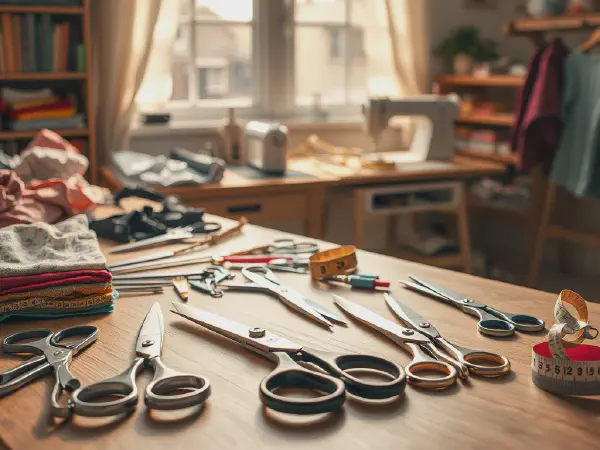Choosing the Right Fabric Scissors for Your Project

Fabric Scissors Selection: A Comprehensive Guide
When it comes to sewing and crafting, selecting the right tools is essential for achieving professional-quality results. Fabric scissors selection is especially critical because the right pair of scissors can make all the difference in the quality of the cuts and the overall enjoyment of the crafting experience. This article explores how to choose the best fabric scissors for your projects, ensuring that every cut is precise and effortless.
Understanding the different types of fabric scissors available is crucial for making an informed choice. Fabric scissors come in various forms, each designed for specific tasks. By familiarizing yourself with these types—ranging from sewing scissors to specialty shears—you can better determine which ones will best meet your sewing needs. Furthermore, considering factors such as materials, comfort, and maintenance practices will also ensure longevity and performance in your selected fabric scissors.
The fabric scissors selection process can be overwhelming, given the multitude of options on the market. However, having a solid understanding of what to look for can simplify this process. Comfort, blade quality, and purpose all play vital roles in the decision-making process. Moreover, being attentive to your specific sewing projects will guide you to the perfect pair of scissors, whether they are for intricate embroidery or simple fabric cutting.
Maintenance of your fabric scissors is just as important as the initial selection process. Maintaining sharp blades and proper cleaning techniques contributes to the scissors' longevity and performance. Regularly sharpening and knowing when to replace your scissors will ensure that they remain in top condition, helping you produce clean cuts even after extensive use. This article will address these aspects, providing a well-rounded perspective on fabric scissors selection and maintenance.
In summary, the right fabric scissors selection can transform your sewing experience. By understanding the types of scissors available, considering your project needs, and maintaining your tools, you can enhance your productivity and creativity. Let's delve deeper into the specifics, starting with the various types of fabric scissors and their respective benefits.
Types of Fabric Scissors
When it comes to fabric scissors, there are several types that fall under the category of sewing scissors. These include regular sewing scissors, which are multi-purpose tools designed for general fabric cutting. They are often favored for their sharp blades and comfortable grip, making them ideal for cutting a variety of materials. Another popular option is embroidery scissors, which feature a fine point for intricate cutting and detailed work. Each type serves a unique purpose, suggesting that the benefits of sewing scissors for fabric extend beyond simple cutting.
Pinking shears are another category worth mentioning. These scissors feature a serrated blade that cuts fabric in a zigzag pattern, preventing fraying. They're particularly useful for edges on woven fabrics, reducing the need for additional finishing. Knowing when to use pinking shears can enhance your fabric handling, adding a professional touch to your projects.
Rotary cutters are a specialty tool that has gained popularity in the quilting and craft community. They offer a circular blade that glides across fabric, allowing for straight, clean lines with little effort. The usage of rotary cutters can provide a more efficient cutting process compared to traditional scissors, especially for multiple layers or intricate designs. Understanding when to employ rotary cutters can drastically improve your fabric cutting experience.
When it comes to choosing between regular and specialty scissors, the decision should depend on your specific sewing needs. Regular scissors are versatile and can handle a broad range of tasks, while specialty scissors offer precision for niche projects. Knowing when to utilize these different types will elevate your sewing capabilities and optimize your fabric scissors selection.
A significant distinction lies in how fabric scissors differ from household scissors. Fabric scissors are specifically designed for cutting fabric with precision, while household scissors often lack the blade sharpness and ergonomic design needed for sewing applications. Understanding these differences will help you avoid damaging your fabric and ensure that you achieve the desired outcome in your projects.
Factors to Consider
One key factor in fabric scissors selection is the blade material. High-carbon stainless steel is often regarded as the best option for fabric scissors due to its longevity and resistance to rust and wear. Ensuring that your scissors are made from quality materials guarantees that you will get a clean cut and reduces the likelihood of needing replacements frequently.
Size is another vital consideration when selecting fabric scissors. Depending on the nature of your project—be it clothing, quilting, or crafts—the size of the scissors can impact your cutting efficiency. Scissors that are too small may strain your hand during extended use, while those that are too large may be unwieldy for detailed work. It’s crucial to choose scissors that align with your project needs for optimum results.
Ergonomics and comfort also play a critical role in the fabric scissors selection process. Since sewing often involves prolonged use of scissors, choosing a pair that feels comfortable in your hand is essential. Look for features like padded grips, finger rests, and lightweight designs that promote ease of use and reduce the risk of fatigue or strain.
Blade sharpness is directly related to your cutting technique. Having a sharp pair of fabric scissors can significantly reduce the effort required to cut through different materials, resulting in cleaner cuts and a more enjoyable sewing experience. Pay close attention to blade sharpness when assessing potential scissors, and consider investing in professional sharpening if necessary to maintain that edge.
Finally, weight considerations are essential for ease of use. Lighter fabric scissors may be easier to handle for long periods, but they should still maintain a balance that enables effective cutting without fatigue. Ensuring that your scissors feel stable and manageable helps keep your focus on your projects without discomfort.
Maintenance of Fabric Scissors
To ensure the longevity of your fabric scissors, knowing how to sharpen them at home is invaluable. Regular sharpening maintains the blade’s edge and enhances cutting performance. You can use a professional sharpening tool or a whetstone, following manufacturer instructions for the best results—keeping your scissors in top shape will save you time and effort in your sewing endeavors.
Cleaning your fabric scissors is equally important. Fabric dust, oil, and adhesive residue can accumulate on the blades over time, affecting performance. A simple cleaning method involves wiping the blades with a cloth dampened with rubbing alcohol or soap and water—ensure they are dry before storing them. Regular cleaning prevents buildup and enhances their cutting efficiency.
Proper storage is also vital for the longevity of your fabric scissors. Store them in a protective case or a designated spot away from other tools to prevent nicks or damage. This practice helps maintain blade sharpness and decreases the likelihood of accidental cuts or scratches.
Recognizing signs of wear is essential to know when to replace your fabric scissors. If you notice chips, rust, or difficulty cutting through fabric, it might be time for a replacement. Investing in a new pair can significantly enhance your sewing experience and prevent frustration during projects.
Preventing rust on your fabric scissors is vital for maintaining their quality. Ensure to wipe them clean after use and consider applying a light coat of mineral oil on the blades for added protection. This simple maintenance step goes a long way in ensuring your scissors remain functional and rust-free for years to come.
Comparative Reviews of Fabric Scissors
When navigating the market for fabric scissors, various brands offer excellent options. Fiskars, Gingher, and Olfa are among the top brands frequently recommended for their durability and cutting performance. Comparing features, warranty options, and customer feedback can greatly help you hone in on the right choice for your sewing projects.
User feedback across various platforms indicates a consensus that high-quality fabric scissors yield better cutting outcomes, leading to fewer frustrations during projects. Customers often underline the importance of blade sharpness, ergonomic designs, and overall comfort as key factors in their reviews. Understanding what users appreciate can better inform your fabric scissors selection.
Price versus quality is a common consideration when choosing fabric scissors. While budget-friendly options may seem appealing, investing in quality scissors generally provides better performance and durability. A higher initial cost may result in long-term savings, reducing the need for frequent replacements or repairs.
For professional fabric cutting, many experts recommend investing in premium fabric scissors known for their precision. Brands like Gingher and Kai are popular among professionals due to their reliability and ability to handle a variety of fabrics with ease. Understanding which tools professionals rely on will help you understand what you should include in your fabric scissors selection.
If you are just starting your sewing journey, selecting the best fabric scissors for beginners is crucial. Look for quality, easy-to-handle designs that provide good value for money, such as Fiskars and Westcott. These brands are known for producing reliable, affordable options that cater to new sewists without sacrificing quality.
Project-Specific Scissor Recommendations
For quilting projects, it’s essential to choose the right fabric scissors. Look for dedicated rotary cutters with interchangeable blades or a good pair of fabric scissors with a longer blade, which can easily cut through multiple layers. Brands like Olfa are popular for quilting projects, catering to both precision and efficiency in fabric handling.
When choosing scissors for garment making, a high-quality pair of dressmaker’s shears is recommended. These should feature a longer blade and a comfortable grip to handle various fabric types smoothly. Scissors from brands like Gingher provide the quality needed for garment construction and detailing, making them a great choice.
Crafting with fabric often requires a versatile tool. A good pair of fabric scissors that blends comfort and sharpness can tackle different crafting materials efficiently. Brands such as Fiskars offer general-purpose fabric scissors ideal for various crafting projects, ensuring versatility in your toolkit.
For upholstery work, specialized heavy-duty scissors will be necessary due to the thicker and tougher materials used. Brands like Weil offer strong, durable upholstery scissors that can handle a variety of fabric types while maintaining sharp, clean cuts.
Finally, for those engaged in embroidery and appliqué, smaller, more precise scissors are essential. Embroidery scissors with fine tips, such as those from the brand Gingher, allow for intricate designs and detailed work. Choosing the right scissors will ensure that you execute your embroidery projects seamlessly.
